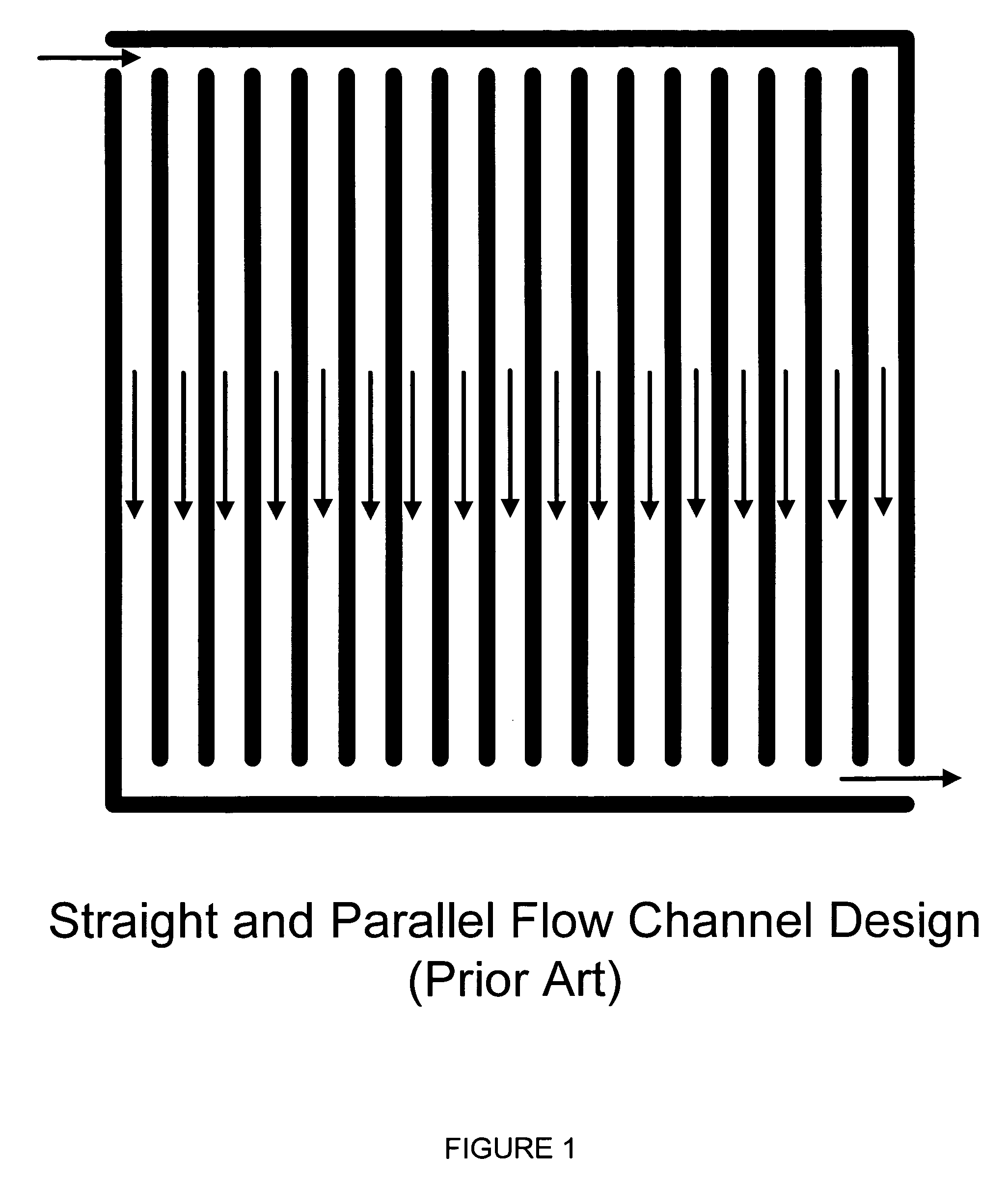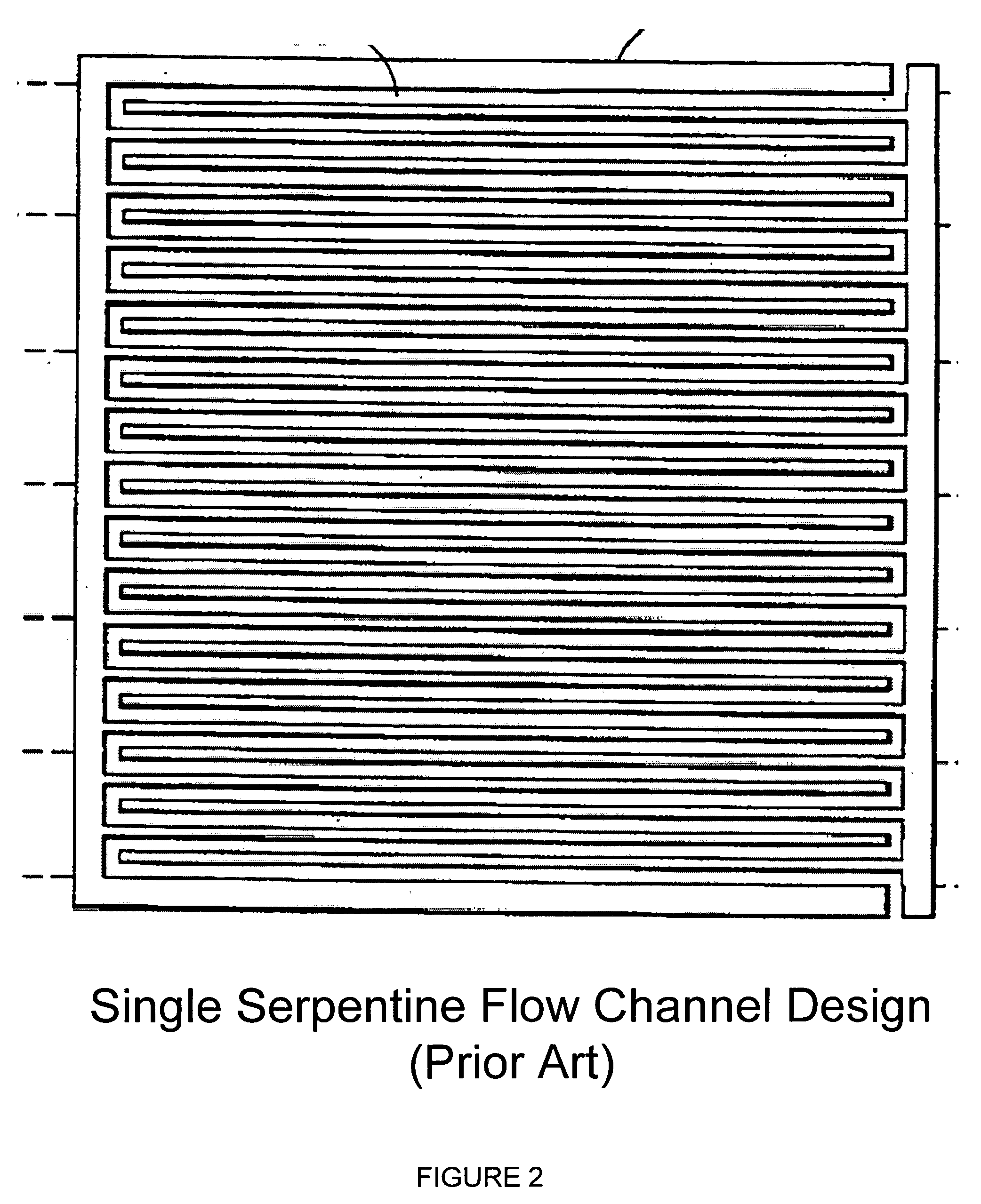Flow field plate for use in fuel cells
a flow field and fuel cell technology, applied in the field of electric fuel cells, can solve the problems of poor water management, increased cell voltage loss, and promote water flooding, and achieve the effect of improving weight, size and manufacturability characteristics
- Summary
- Abstract
- Description
- Claims
- Application Information
AI Technical Summary
Benefits of technology
Problems solved by technology
Method used
Image
Examples
first embodiment
[0068]FIG. 4 illustrates the present invention providing a nearly constant flow rate over the entire active area. FIG. 4 is illustrated to correspond to an anode plate, with assumptions of 70% hydrogen concentration in reformate and 80% hydrogen utilization efficiency.
[0069] Generally, the flow field plate 10 includes a network of supply flow passages or inlet manifold 11 for supplying the fuel to the flow field 18 and a network of flow passages or outlet manifold 12 for receiving the reactants discharging from the flow field. The flow field includes a single or plurality of inlets or outlets fluidly communicating with the networks of supplying and exhausting flow passages. On the flow field plate 10, there may also be inlets 13 for oxygen-containing gas supply, outlets 14 for the oxygen-containing gas exhaust, inlets 16 and outlets 15 for coolant flow.
[0070] As shown in FIG. 4, the reactant gas flows through the manifold 11 fluidly communicating with plurality of flow channels 18a...
third embodiment
[0075]FIGS. 6 and 7 illustrate anode flow field plates 30, 40 according to a second and a third embodiment according to the present invention, in which the flow channels are provided in a fashion similar to the conventional serpentine pattern. Similarly to FIG. 4 these two figures show the flow field based on a “Constant Gas Flow Rate Approach” in which a hydrogen concentration of 70% and a hydrogen utilization of 80% are assumed. The flow channels 38, 48 are reduced as 14-10-8-7-6, for a total of 45 channels. Replacing the headers 17 in FIG. 1, several connecting and redistributing mechanisms 37, 47 are provided, which allow the flow channels 38, 48 to decrease from the number in a previous zone to the number of the following zone according to the determined decrease rate.
[0076]FIGS. 8 and 9 schematically show cathode flow field plates 50, 60 according to a second and third embodiment of the present invention, in which the flow channels 58, 68 are provided in a fashion similar to t...
fourth embodiment
[0078] Now, referring to FIG. 10 and to FIG. 11, there is shown the present invention, based on the approach of “Constant Molecules per Active Area”, which would maximize the utilization of the catalysts. The anode plate 70 of FIG. 10 is assumed to have a 70% hydrogen concentration and an 80% hydrogen utilization. The cathode plate 80 of FIG. 11 assumed an oxygen concentration of 21% and an oxygen utilization of 50%. Based on this approach, the number of grooves will decrease exponentially (equation (5)) to the number that equals the number on the inlet side multiplied by (1-η0). In the case of FIG. 10, the number of grooves decreases as 16-11-7-5-3, while in FIG. 11 it is 19-13-10, with both giving the same total of 42 channels. Compared to the approach of “Constant Gas Flow Rate”, the approach of “Constant Molecules per Active Area” leads to faster decrease in the number of flow channels or flow areas from the inlet toward the outlet. Therefore, the gas velocity would expect to in...
PUM
| Property | Measurement | Unit |
|---|---|---|
| temperature | aaaaa | aaaaa |
| temperature | aaaaa | aaaaa |
| current density | aaaaa | aaaaa |
Abstract
Description
Claims
Application Information
 Login to View More
Login to View More - R&D
- Intellectual Property
- Life Sciences
- Materials
- Tech Scout
- Unparalleled Data Quality
- Higher Quality Content
- 60% Fewer Hallucinations
Browse by: Latest US Patents, China's latest patents, Technical Efficacy Thesaurus, Application Domain, Technology Topic, Popular Technical Reports.
© 2025 PatSnap. All rights reserved.Legal|Privacy policy|Modern Slavery Act Transparency Statement|Sitemap|About US| Contact US: help@patsnap.com



